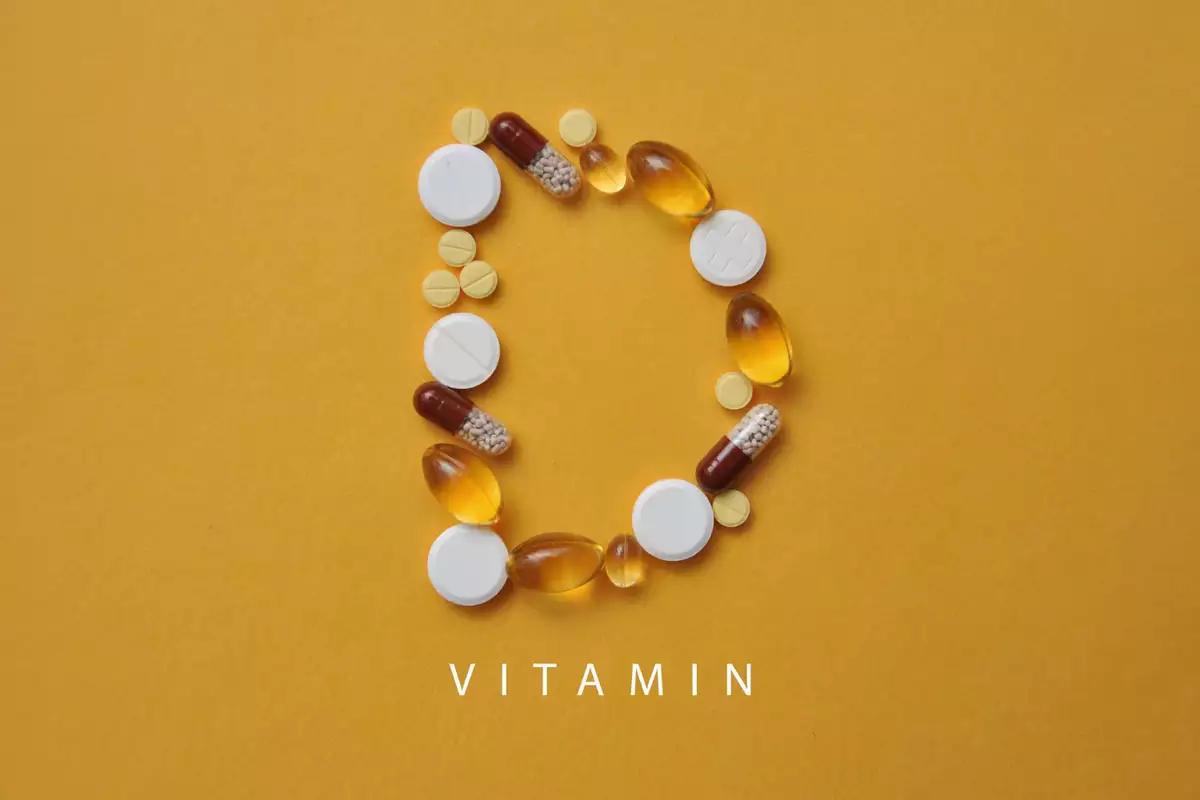Vitamin D plays an extremely important role in our body: It participates in regulating inflammatory processes, supports metabolism, and helps in the formation of energy. In addition, vitamin D is essential for bone health and the prevention of diseases such as rickets and osteoporosis. In this article, we will look at the main sources of this vitamin and its potential interactions with medications and supplements.

1. Forms and sources of vitamin D
Main types of vitamin D
The most common forms of vitamin D are:
- Ergocalciferol (vitamin D2)
- Cholecalciferol (vitamin D3)
These forms can be obtained from various sources, namely.
Foods
These include oily fish (salmon, tuna), egg yolks, fortified milk, etc.
Sunlight
The skin produces its vitamin D under the influence of ultraviolet rays.
Food supplements
Tablet or capsule forms are useful if taken on a doctor’s recommendation, especially if you have insufficient vitamin D levels in your body.
2. The importance of consulting a doctor first
If you decide to take vitamin D as a supplement, it is essential to discuss it with a healthcare professional beforehand. Vitamin D can interact with several medications and other nutrients, affecting their effectiveness or increasing the risk of side effects.
Below are the main groups of drugs with which vitamin D can have significant (but mostly not too risky) interactions.
3. Interaction with specific groups of drugs
3.1. Statins
- What are these medicines?
Statins (HMG-CoA reductase inhibitors) are drugs for lowering cholesterol levels (e.g., atorvastatin, lovastatin, simvastatin).
How do they interact with vitamin D?
- Vitamin D can reduce the absorption of statins into the bloodstream, potentially reducing their concentration.
- At the same time, since statins affect cholesterol levels, this may also affect the natural production of vitamin D in the body (since vitamin D is synthesised from cholesterol derivatives).
- Both substances are broken down by the enzyme cytochrome P450 3A4 (CYP3A4), which can lead to competition: the level of one drug increases and the other decreases.
What to do.
Despite the possible effects, blood fat (lipids and cholesterol) levels usually do not change significantly. However, if you are taking statins, you should inform your doctor before starting a course of vitamin D.
3.2. Orlistat
- What is it prescribed for?
Orlistat (Xenical, Alli) is a weight loss medicine. It blocks fat absorption from the diet in the stomach and intestines, eliminating it with faeces.
- How does it interact with vitamin D?
Since vitamin D is a fat-soluble vitamin, Orlistat may interfere with its complete absorption in the gastrointestinal tract, reducing the overall level of this nutrient in the body.
- Recommendations.
If you are taking Orlistat and vitamin D simultaneously, your doctor may advise you to separate them for at least two hours and monitor your vitamin D levels.
3.3 Thiazide diuretics
What are these medicines?
- Thiazide diuretics (“water pills”) are prescribed for cardiovascular diseases to reduce fluid retention. Examples: hydrochlorothiazide, chlorothiazide.
Features of interaction
- Vitamin D promotes calcium absorption, and thiazides increase blood calcium levels by reducing its excretion in the urine.
- Combining large doses of vitamin D and thiazides may contribute to hypercalcaemia (excess calcium in the blood).
- This risk is higher in older adults and people with impaired renal function.
Practical advice
When taking thiazide diuretics and high doses of vitamin D, you should consult a doctor to avoid hypercalcaemia.
3.4. Steroids
What are they used for?
- Corticosteroids (e.g., prednisone, hydrocortisone) are prescribed to reduce inflammation and treat autoimmune and certain chronic diseases (asthma, ulcerative colitis, etc.).
Interaction with steroids
Research suggests that steroids may impair calcium absorption and, therefore, affect the effectiveness of vitamin D.
In some cases, people taking steroids are more likely to have low levels of vitamin D, although other factors (diet, lack of sunlight, general bone health) also influence these values.
3.5. Bile acid sequestrants
- What are they?
Bile acid sequestrants include cholestyramine, colesevelam and colestipol. They are used to lower cholesterol and blood sugar.
- How do they affect vitamin D?
These drugs bind bile acid in the intestines, reducing the absorption of fats.
At the same time, they can bind fat-soluble vitamins (including vitamin D), so the body’s level of vitamin D may decrease.
- Tip.
To reduce the risk of interaction, take a vitamin D supplement four hours before or four hours after taking bile acid sequestrants.
3.6. Digoxin
- Prescribing digoxin
Digoxin (lanoxin) is used in heart diseases, particularly arrhythmias and heart failure.
- How does it interact with vitamin D?
High doses of vitamin D can cause excess calcium (hypercalcaemia).
Increased calcium levels while taking digoxin may increase the risk of abnormal heart rhythms (arrhythmias).
What is essential to know?
The risk of complications is low if you do not exceed the upper limit of 4000 IU of vitamin D per day.
Your doctor will monitor your calcium, digoxin, and vitamin D levels if necessary.
3.7. Diltiazem
- What is it used for?
Diltiazem (Cardizem) is prescribed for certain diseases of the heart and blood vessels, in particular, hypertension and angina pectoris.
- Potential interactions
Vitamin D in high doses may increase the risk of hypercalcaemia.
In combination with diltiazem, such excess calcium may increase the risk of heart rhythm disturbances.
How to protect yourself?
Like digoxin, with moderate vitamin D intake (no more than 4000 IU/day), interaction with diltiazem is unlikely. It is essential to inform your doctor about all medications you are taking.
3.8. Mineral oil
- What is this medicine?
Mineral oil is an over-the-counter laxative that helps with bowel movements by keeping water in the intestines.
- How can it affect vitamin D?
Vitamin D is fat-soluble, so the diet requires fats or oils to be absorbed.
Mineral oil can “bind” vitamin D in the gastrointestinal tract, reducing absorption.
How to avoid problems?
The risk of serious complications is low since mineral oil is usually taken only when needed and for a short time. However, taking a break of several hours between taking vitamin D and mineral oil is advisable.
4. Interactions of vitamin D with other supplements
4.1 Calcium
- Normal doses
Taking calcium with vitamin D is usually beneficial because D improves calcium absorption.
- High doses
It can increase calcium levels to the point of hypercalcaemia, especially if too much of both is taken at the same time.
4.2. Magnesium
- Increased absorption
Vitamin D can stimulate the absorption of magnesium.
- For whom it is relevant
The effect is more noticeable in people with magnesium deficiency. With normal magnesium levels, there are usually no significant changes.
5. When to consult a doctor
In most cases, vitamin D reduces the level of other medicines in the blood, or vice versa; its absorption may decrease. However, there are situations when hypercalcaemia (excess calcium) can occur.
Symptoms of hypercalcaemia may include:
- Nausea or vomiting
- Increased thirst and frequent urination
- Muscle weakness
- Bone pain
- Confusion of consciousness
You should immediately consult a doctor if you experience any of these symptoms.
Special attention to patients with heart disease
If you are taking medications for arrhythmia or other heart conditions, watch out for signs that indicate deterioration (dizziness, fast or slow heartbeat, chest pain). If you experience any of these symptoms, consult a specialist immediately. 9
6. Conclusions.
Vitamin D has numerous bodily functions, including regulating inflammation, improving metabolism, and maintaining bone tissue. Its deficiency is associated with a risk of rickets, osteoporosis and other disorders.
Vitamin D can generally be obtained through food, sunlight, or supplements. However, discussing possible interactions with your healthcare professional is essential if you are taking certain medications (e.g., statins, thiazide diuretics, arrhythmia drugs) or additional nutrients (calcium, magnesium). The correct approach to dosing and monitoring calcium and vitamin D levels will help prevent undesirable effects and ensure maximum benefit from treatment.
Important! The statistical information presented in medical articles reflects general trends and does not consider each person’s characteristics. Always consult your doctor to make personalised decisions about your health.






